Mercedosaurus Rex at Indianapolic Park
Part 15: From the last weekend of May '94 to the end of the season
Author
- Henri Greuter
Date
- December 4, 2009; with September 25, 2014 additions
Related articles
- March-Alfa Romeo 90CA - Fiasco Italo-Brittanico, by Henri Greuter
- March-Porsche 90P - The last oddball at the Indianapolis Motor Speedway, by Henri Greuter
- Penske-Mercedes PC23-500I - Mercedosaurus Rex at Indianapolic Park, by Henri Greuter
- Introduction
- Part 1: Penske Racing at Indianapolis - new standards
- Part 2: Ilmor Engineering at Indianapolis
- Part 3: Mercedes, Benz and Mercedes-Benz at Indianapolis up until 1993
- Part 4: Equivalency formulas - waiting for things to go wrong
- Part 5: Stock blocks - keeping them rolling and promoting 'Born in the USA' technology
- Part 6: Indianapolis 1991 - Chevy And Rich Team owners
- Part 7: The Speedway narrowed, its speeds lowered
- Part 8: The forerunner
- Part 9: Pre-May '94 plans
- Part 10: Penske PC23 - a home for the engine
- Part 11: The 1994 Indycar season until mid-April
- Part 12: The unfair advantage and when others have it
- Part 13: Practice during the 1994 'Month of May'
- Part 14: Other bespoke-design 209s
- Part 16: Could the Mercedes Benz 500I have been stopped in time?
- Part 17: Creating an extinct species without it being forbidden, initially at least
- Part 18: The 1995 '500' - Did the Mercedosaurus bite its masters after all?
- Part 19: A possible twist of fate for Rahal-Hogan and Penske as a legacy of the 500I
- Part 20: Re-evaluation of our verdict
- Part 21: PC23's further active career after 1994
- Part 22: USAC’s points of views and some answers
- Part 23: The loose ends that didn’t fit in anywhere else and the epilogue
- Part 24: "Plan your work; work your plan" - Chuck Sprague on the PC23
- Appendix 1: Specifications
- Appendix 2: Car and driver appearances and performances during the Month of May 1994
- Appendix 3: Chassis, entry, practice and race numbers in 1994
- Appendix 4: PC23's 1994 results sans Mercedes Benz 500I
- Appendix 5: PC23's 1995-'96 results sans Mercedes Benz 500I
- Appendix 6: A reflection on the PC23 chassis used by Team Penske in 1994
- Appendix 7: A review of Beast by Jade Gurss
Who?Emerson Fittipaldi What?Penske-Mercedes PC23 Where?Indianapolis When?1994 Indianapolis 500, Race Day (May 29, 1994) |
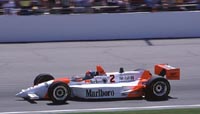 |
Why?
The race was a runaway affair for Penske Racing.
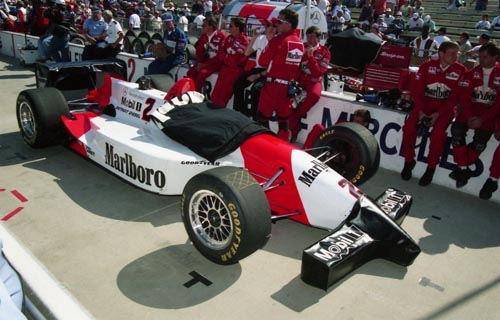
Fittipaldi's mount parked on pit lane in the early morning of race day. (photo HG)

Birthday Boy Al Unser Sr with his son and, what at that time was still his daughter-in-law, Shelley in the razmattaz preceding the start. (photo HG)
The start of the race was ragged and in the last turn before the start Unser and Fittipaldi blocked their fellow front-row started Boesel to such an extent he had to hit the brakes and lost all speed and momentum to upset the two Penske drivers.

Seconds after the start, the shape of things to come: Al and Emmo the first two cars in sight after dealing with Boesel even before the race had actually started. (photo HG)
During the first pit stops for Unser and Tracy the engine stalled and they lost time on the track. Unser's time loss made him drop to third place. Tracy was thrown back much further in the field, ruining what chance he still had to do well in the race.

Paul Tracy during the race. Despite the Mercedes power behind him, he was unable to fight his way to the front. (photo HG)
In fact, Paul Tracy never was a factor during the race and after 92 laps retired with a car smoking badly, causing consternation within the team. Engine related or not? (Remember the piston rings…) It was, however, the turbo that had gone, leaving Paul classified in 23rd position. Interviewed after the race Paul explained that he had stalled during his first stop because of the heavy traffic on pit lane but still had good hopes to claw back into the top 6.
Al Unser led the first 22 laps, then Fittipaldi took over. Both these drivers used a different chassis setup, with Al using more downforce. It appeared that Fittipaldi had the better setup since he was the faster of the two remaining Penskes.
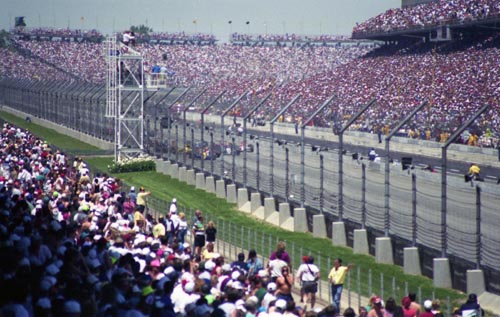
This is an impression of what was the most thrilling moment in the entire race. About the entire field bunched up in one big pack at full speed over the straight, three to four cars next to another on occasion. No accidents but spectacular to watch. (photo HG)
In what eventually became his last pit stop, Unser had a slight wing adjustment and almost stalled his engine yet again but managed to keep the car rolling.
With less than 20 laps to go Fittipaldi managed to lap his teammate who was still in second place! It made him briefly the only driver in the lead lap.

Emerson undoubtly looked the fastest of the day. (photo courtesy Daimler-Benz Firmen Archif, used with permission)
But it was a situation that lasted very briefly since Al got back on the lead lap again and, on his 185th lap, when Fittipaldi set up an attempt to pass Unser yet again, he briefly lost control in Turn 4. Fitti corrected but the rear part of the car stepped out and slammed into the wall.

The decisive moment in the race: Fittipaldi hitting the wall, ending his chance to become the first Brazilian three-time winner. (photo copyright IMS Photos, used with permission)
The wrecked car slid a long way, finally coming to a rest on the front straight almost opposite the Penske pits. An utterly dominant performance resulting in only a 17th place instead.
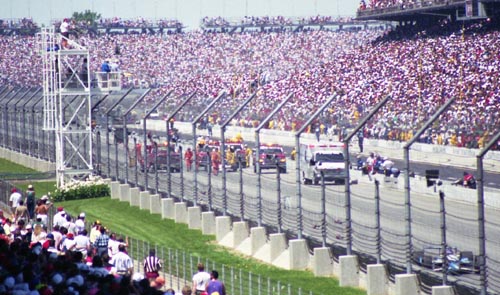
The best I could make of the scene after Emerson's crash. (photo HG)
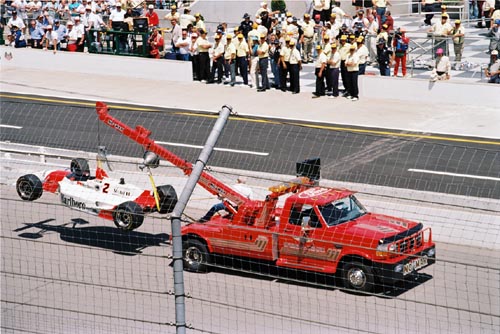
And this is how Fitti's car could be seen by the people at the front stretch for the last time. (photo copyright IMS Photos, used with permission)
Fortunately for Team Penske, Al Unser Jr's car survived. But it was more difficult then it appeared to be. Remember that Al stalled the engine after his first pitstop and later on had more difficulties accelerating out of the pits again. Al also had troubles with the two-way radio not working properly, which saw Roger Penske using the time-honoured blackboard and chalk again to pass on notes to Al.

Al Unser heading the field in the last laps of the race. (photo HG)
On track however, Al stayed out of trouble and, although it was under a yellow flag because of Stan Fox hitting the wall in Unser's 197th lap, Unser got the chequered flag and was the winner. The near perfect ending of a near impossible project. The 'Mercedosaurus Benz' had achieved its mission. Team Penske had pulled off the miracle, the perfect ending to a daunting project. Benefiting from a rule that was more or less invented to work against them, Penske turned it into their advantage. It was likely the zenith of Penske's career as a team owner up until that time.

Al on the beginning of his victory lap. (photo HG)
A 1st, 17th and 23rd place, at first sight, may not look that impressive. It must, however be said that due to Fittipaldi's error the team lost out on a convincing double. Up until the moment Fittipaldi retired from the race, he and Unser Jr had rarely been out of the top three, make that the top two. To hammer down the fact that nobody stood a chance against the Penskes of Fittipaldi and Unser: Fittipaldi led 145 of 200 laps, Unser 48. Jacques Villeneuve (2nd at the finish) was the only other driver to lead during the race: 7 laps.
Make no mistake, don't be deceived because of the other two cars ending up only 17th and 23rd. Tracy's race was indeed rather anonymous. But Unser Jr and Fittipaldi had the entire field covered and they left the field to the mercy of fate and actions of Lady Luck to come to the rescue of the other competitors.
What about Fittipaldi's error that cost him the race? Why was he so eager to put a lap on Al Jr? In fact this wasn't so strange. The problem for Fittipaldi was that early in the race a hotdog wrapper had entered his sidepod, causing the car to overheat and forcing him to make an emergency pit stop to have it removed. As a result of that, he was out of sequence with the majority of the field and due to make an extra 'splash & dash' stop later on during the race. If he had a lap on Unser in case of a yellow he would be safe and even be able to make a pit stop. Hence his efforts to create as much distance between him and Al Jr as possible in order to make this extra stop without losing the lead and, in that phase of the event, the entire race. But it was all in vain for Fittipaldi.
Fittipaldi's comments as found in a post-race Mercedes press release were:
"The car was flying. I nearly corrected it, but it was too late. I am glad Al Jr won with Mercedes Benz."
Where the Penskes were winning the race was obvious. Heading the field for 193 of the 200 laps, it was clear to see that with every restart the cars ran away from their opposition as if they were standing still. Michael Andretti stated that when a Penske came by on the straights it was simply impossible to even catch a draft from them, let alone to try to stay in their slipstream. Fittipaldi was measured at 244mph on the straight on one occasion. In the post race Mercedes press bulletin Al Jr stated:
"The Mercedes made it easy to pass everybody down the straightway."
Were the cars performing at their maximum? It is very likely that they were and that the cars weren't as superior as feared (and believed) to be. It had been early May before the first example of an engine survived a 500-mile distance at Michigan. And although the surplus of power was already staggering, most priority had gone to giving the engine its power advantage and making it reliable enough to go the distance. According to the stories, for the sake of reliability Ilmor never tried to extract yet more power from the engine. So some of the development potential within the engine wasn't tapped off.
The same can be said about the chassis. It has been stated in several media bulletins, and confirmed by Penske team members, that the cars used at Indianapolis weren't fully sorted to make the most out of the available power, cornering abilities in particular being rather weak. The cars were a bit unstable when entering the corners after having reached their top speeds, and carrying their speed through the turns was a bit of a problem. But since overall lap speeds were competive, if not superior, it was deemed satisfactory and the team concentrated on assuring the brand new engines would survive 500 miles. Time to hone the chassis-engine combination to further perfection wasn't available although they did what they could.
Most onlookers credited the less than perfect handling to the fact that the 500I had a higher C of G, thus giving the car a higher C of G as well. Another factor could have been the higher engine cover which disturbed the air flow onto the rear wing, making it less effective.
Addition made in September 2014: At the time it was generally believed that the 500I had a higher C of G due to its lay-out, being so much taller making up for most of that difference. In his book Beast, Jade Gurss reveals that the 265E's C of G was a mere 2.98 mm higher than that of the 265D! A difference that cannot be used to explain any handling difficulties with the chassis. For more details on the C of G comparison, see the footnote added to this chapter.
What would have happened had the engine come into existence a bit earlier and had it been better known by its builders? More development potential would have been untapped and the team would have had more time to 'mate' the PC23 chassis with the engine. We can only wonder.
The following may read a bit as an insult to the car. But the PC23-500I, despite everything that was done about it to make it work, can be argued to be much more of a one-off hybrid than a purposely designed, fully sorted out purebred. But even then, it was more than capable of doing the job.
In the same post-race Mercedes press release Roger Penske was quoted as having said:
"To be able to deliver the pole and the race proves we have a great group of people. I play the role of the quarterback, I suppose, but our drivers and crews are the ones who won it."
A comment about the drivers' performances
Knowing that Paul Tracy and Al Unser Jr did most of the test work while Fittipaldi wasn't involved, the curious situation appears that the driver with the least experience with the car was the most dominant driver on race day and one of the two which performed the best of all during the entire month of May. The man with the most experience however (Tracy) did the worst, at least at first sight.
All three drivers had turned about an equal amount of laps during the first week of practice, although Unser and Fittipaldi topped the list. During the second week of practice, however, it was Al and Emerson in particular who reeled in the largest numbers of laps with the two available backup cars to search for a decent race set-up. Why Paul was not participating in this activity is a bit unclear. But there are a few thoughts that can be brought up about what could have been a factor.
Regarding Fittipaldi it was known that he was highly motivated for prestigious events like Indianapolis, his record at the Speedway proving such. Al Unser's 'love affair' with the Speedway had also been obvious in the past. Perhaps running ahead of schedule, in later years there was even more evidence shown by Al Jr as to what participating at Indianapolis meant to him. Paul Tracy on the other hand appeared to be less daunted and impressed by the impact of the Speedway, at least in the early part of his career. But Indianapolis was special to both Al and Emerson, more than it appeared to be for Paul. That may have been one of the reasons why they were doing most of the test work. At the moments when it really mattered: when the car that was specially created for this track, this event, could be driven at the location it was built for. Besides that, was 'Junior team member' Tracy getting a bit bored with all the monotonous lapping after all the work he had done in the previous three months already?
Briefly: The other pushrod-engined cars in the race
As for the three pushrod V6-engined cars in the race, Guerrero was, once again, the first retirement, like he had been in the 1992 race with the very same chassis. This time however he crashed out in the 21st lap in Turn 1. Two years before he had crashed out on the warm-up lap, and thus never started the race.
The two Menard V6 entries however performed rather well. Both made it into the top 10 and were mixing it with the non-PC23-500I participants. Brayton was forced to retire after 116 laps with engine failure. Cheever made it to the finish and was classified 8th with 197 laps. Perhaps more tellingly, only Robbie Gordon who finished 5th in a XB-powered Lola T94 bettered Cheever if it came to the Lola-mounted drivers.
The aftermath for the PC23 during 1994
Despite efforts to have the engine legalized for use in CART races later that year, this didn't happen, so the racing world didn't see the Mercedes Benz 500I engine again that year. It didn't matter much for the invincibility of the Penske PC23 chassis. The week after the 500 miles at Indianapolis the CART drivers met again at Milwaukee. Team Penske ran some of the cars which had been fitted with Mercedes engines in the preceding weeks but this time with the regular Ilmor 265D engines. Rain ended the race 8 laps early. Unser won again, followed by Fittipaldi who was the only other car on the lead lap. Third man, Paul Tracy was already two laps down but everybody else even more! A triple for Team Penske.
Out of the 11 CART races that followed after Milwaukee, Penske won eight more races, four of those, like Milwaukee, were triple victories. At the end of the year Penske had won 12 races, 5 of this dozen were triples, two doubles, a single 1-3 and four victories with no other Penske driver on the podium.
Some of those victories were crushingly dominant. For example, Penske won with a triple at New Hampshire. After 44 laps the three Penskes had lapped the entire field, and when they had covered the full race distance of 200 laps, fourth place finisher Raul Boesel was four laps behind!
One of the doubles, however, was perhaps the most difficult moment in the season for the team. It could have been another triple. At Detroit a determined Paul Tracy followed race leader Unser Jr, hoping to force Al into an error. However, Paul made a slight error himself and ran into his team mate, pushing Al into a tyre wall. Paul survived the contact, took the lead and continued the race, eventually winning it. But even Paul wasn't overjoyed about this victory, knowing that he had spoiled the result for one of his team mates.
Obviously, the Penske team had some very good politicians in the team because, at least for the outside world, the team continued the season without any further difficulties and animosity between Al and Paul.
In the four races that were lost, one of them saw 2nd and 3rd for Penske, one race they won at least second and on one occasion third place was for Penske. There was only one race where no Penske driver made it onto the rostrum. Ironically, of all places to have this happen, it was at one of Roger Penske's own tracks: Michigan. Even more curious, the fastest Penske in qualifying had been Stefan Johansson in a one-year old PC22!
During the race, the PC23s were competitive, Unser retiring while leading. But the crushing superiority the PC23 had shown on the 1-mile ovals wasn't there.
Road America was lost to Jacques Villeneuve who made the best use of a restart shortly before the finish of the race and beat the Penske panzers in a sprint to the first corner, and then successfully defended his position using a low drag, high straightline speed.
To rub it in even deeper, of the five triple victories, one time 3rd-place finisher Tracy was the first driver not to make the full distance. On one occasion, two more drivers finished the full distance, the other three times the three Penske drivers were the only drivers to cover the full race distance.
The audience and TV watchers became used to a habit performed by the surviving Penske drivers that, although justified, was also seen by some as overdoing it. The winner and his surviving team mates made their victory lap driving side by side, two or three abreast. It was an intimidating sight each and every time.
Remember the just-over-225mph highest average achieved in testing in mid-April at Michigan with the PC23-500I? Fittipaldi was the fastest PC23-Ilmor/D in practice (7th fastest overall) with a 228.710 average. Pole sitter Nigel Mansell had an average of 233.738mph.
At Nazareth (mid-September), Fittipaldi was the fastest in qualifying with a lap time of 19.397, remember, in conditions that weren't as good as in mid-September. The PC23-500I had achieved 19.90 as its fastest time mid-April.
Needless to say, the 1994 championship was a clean sweep for Penske too, Unser becoming champion, with Fittipaldi second and Tracy third.
Unser was truly the constant factor all season long, taking seven more victories in addition to Indianapolis.
Fittpaldi's season was highlighted by the win at Phoenix, the second race of the season. His performance at Indianapolis was worth being the highpoint if not for that late-race mishap. During the rest of the season he failed to win any races but steadily kept scoring podium places.
Paul Tracy had an unlucky start of the season. At Phoenix for example, he was involved in an accident while leading the race. With a quarter of the season done he had a mere 2 points for two poles. From Indianapolis on, however, it appeared as if (results-wise) he finally got a grip on the situation with two highly motivated team mates and he too added a load of podium places to his tally, including three victories. In the events held after Indianapolis Paul actually outscored Emerson by 10 points. That he lost out to Emerson in the season standings was mostly due to the first four races in which he failed to finish, often retiring from the lead due to reasons beyond his control. Season reviews about the 1994 CART season testify that Paul's season was better than it appeared at first sight. Despite have scored only 2 points after the first quarter of the season, the 1994 Autocourse Indycar Yearbook still rated Paul second in the Driver's Top 10 of the season and praised Paul for being a team player.
The Penske PC23 went into the history books as one of the most successful modern-day Indycars. It appears as if it even didn't need that special Mercedes engine to become a legendary car. And then remember that the car never used the active suspension developed by the Penske team. What would the PC23 have achieved that season if it had been fitted with this system?
Conclusions about the Penske PC23 at the end of 1994
With hindsight however, the PC23 became even more legendary just because of the fact that it had raced at Indy with the Mercedes Benz 500I engine. In its 'USAC special' configuration the car became a historic 'Special', a car that created headlines and wrote history like few cars ever had done in racing history. It scored Roger Penske's 10th Indy victory, no doubt one of the most published of them all and one of the most special ones. Little did everyone know how extraordinary this victory eventually was to become, and what legacy the Mercedes Benz 500I was to leave with the Penske team.
As for the Mercedes Benz 500I engine, it certainly was to have a dramatic influence on the immediate history of the 500 Miles at Indianapolis, and maybe for its more long-term future too.
Not to be forgotten: the further 1994 plans with the 500I after May ‘94
Not unsurprisingly, Roger Penske lobbied within CART for his wonder weapon to make it eligible for CART racing as well. The engine was to be made available for other teams too: Rick Galles and Jim Hall were the lucky team owners scheduled to be offered them.
It was a hopeless case. In the late 80s and early 90s CART had already shown to be unwilling to grant the Buick V6-derived stock blocks any more favours than a displacement advantage, the permitted turbo boost remained identical to that of the quadcams: 45 inches of mercury. And after the power display at Indy, it looked increasingly unlikely that CART was willing to grant an even better designed engine than the Buick the advantages it had denied a similar, yet far less efficient engine already. The Mercedes-Benz 500I was destined to remain an 'Indy only' engine in '94 and likely thereafter as well.
Nevertheless, rarely before and ever since had an engine created so much history and made such an impact in a race or event. The only other engines perhaps matching the Mercedes Benz 500I in creating a hype at Indy were the 1952 diesel and the 1967 and 1968 turbines.
More about the Ilmor 265E's C of G
Included in this chapter in September 2014 is an update about the Ilmor 265E's C of G based on information published by Jade Gurss in his book Beast. As far as I know, it has always been suggested that the 265E's C of G was higher than that of its 1994 quadcam brother, the Ilmor 265D. Somehow, even without the bare facts to either disprove or support it, there seem to be enough reasons for reaching this conclusion. A quick look on the engine in comparison with a regular quadcam V8 CART engine of the time made it so easy to instantly accept the theory that the 265E had a higher C of G. For starters, there is the nearly 10 cm additional overall height with the top-heavy inlet plenum towering on its eight lengthy 'support struts', even if those struts were hollow.
Then there is the narrow valve angle of the block, which at 72 degrees is very unusual for a V8. In the case of the contemporary Ilmor engine, the 265D had a block angle of 82 degrees. A smaller V angle for the block automatically results into more parts of and within the cylinder heads being higher up. These two arguements alone are enough to believe in a higher C of G compared with a quadcam engine. As Gurss informed us, it was indeed true. But with such a small margin that it can't be an excuse for causing much difficulties with the handling of the car.
Interestingly enough, the 265E could have had an even less higher C of G because there was opportunity for the camshaft and all that surrounds it to be put a bit lower in the engine block. But Mario Illien opted for making the actual pushrods as short as possible in order to reduce the flex and stress in the valve activation system and thus raise the maximum rev limit. So for good reasons the cam went upwards within the block, and with it the C of G.
While I worked on updates of the 1995 chapters of this site I corresponded with Patrick Morgan, the man who by now can be seen as the treasurer of the 265E project. Although at the time I was already aware of the 265E's marginally higher C of G (I had read Beast), Patrick gave some more details about the C of G measurements Gurss mentioned in his book. Patrick wrote:
"Related to your subject there is a widely held belief that the 265E had a higher centre of gravity than the 265D. I always struggled to believe this as despite the plenum being higher it only has one cam low down rather than 4 up high. A cam is a pretty heavy item and the gears and pendulum dampers to drive them are also heavy not to mention all the support structure in the head to accommodate it all. With the 265E Mario actually designed in the flat top to the cylinder head to add stiffness as all the support structure for the cams, which also adds substantially to the engines overall stiffness, does not have to be there."
"So with this in mind we measured the centre of gravity of both engines back in November to discover the truth. [...] it turned out the 265E has a C of G 3mm higher then the 265D which is next to nothing."
The actual figures as supplied by Patrick Morgan read as follows:
265D Total Mass - 126.5kg
265D C of G from lowest point of sump - 222.92mm
265E Total Mass - 130.0kg
265E C of G from Lowest point of sump - 225.90mm
"Both engines were measured without the clutch and all oil drained as far as possible. Both were complete and were measured with the same looms etc. fitted so they are apples and apples so to speak."
The engine blocks of the 265D (green) and 265E (blue) projected over another makes it clear that if the 265E looks so much larger than the 265D it was not because of the actual engine blocks. They were rather comparable in size. This was of course necessary for the switch from D to E and back. It needs to be pointed out, however, that a few of the components are omitted, like for example the alternator on the D and the inlet plenums on both engines.
The two separate cross signs in each other's immediate vicinity represent the center point of gravity for both engines when built up entirely. The difference is indeed minimal.
Based on these figures it is interesting to note that the engine weight is slightly higher than published in 1994, when figures of 123.5 and 124 kgs were given.
They also clarify that the 265E's weight and its weight distribution were not the biggest reason for the PC23-265E's less than perfect handling, if a reason at all. This is supported by Nigel Bennett's comment in his book Inspired to design saying that the drivers told him in later years that most of the handling problems were related to the larger differences in cornering speeds and top speeds.

